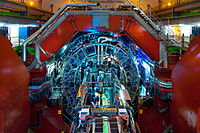
Photo from wikipedia
The advent of thin-gap RPCs, with 1 mm gas gaps instead of 2 mm in the present RPCs, opened the possibility to instrument the inner barrel layer of the ATLAS… Click to show full abstract
The advent of thin-gap RPCs, with 1 mm gas gaps instead of 2 mm in the present RPCs, opened the possibility to instrument the inner barrel layer of the ATLAS muon spectrometer where there is very limited amount of space in radial direction from the beam line. The environment is particularly dense in the barrel end-cap transition region. A compact mechanical structure coping with the expected thickness variations of the assembled RPCs is needed to fit into the limited available space. At the same time the mechanical structure must be sufficiently rigid to keep the deformations of the RPC packages within the allowed envelopes. The tight space constraints make it impossible to achieve the required rigidity with thick paper honeycomb plates as used in the present ATLAS RPCs. For the phase I upgrade of the barrel end-cap transition region of the ATLAS muon spectrometer three 1 mm gap RPCs are put into an aluminium frame. In this frame the RPC triplet is compressed with pre-bent 2 mm thick aluminium plates. The rigidity of the frame is achieved by stiffening rods connecting the lateral structure of the frame. The same concept can be used for the phase II upgrade of the inner layer of the muon spectrometer.
Journal Title: Journal of Instrumentation
Year Published: 2021
Link to full text (if available)
Share on Social Media: Sign Up to like & get
recommendations!